HP Z27q Monitor Review: Aiming For More Pixels
by Brett Howse on December 22, 2015 8:00 AM ESTsRGB Calibration
Calibration of the monitor is done with SpectraCal’s CalMAN 5 suite. For contrast and brightness, the X-Rite i1DisplayPro colorimeter is used, but for the actual color accuracy readings we use the X-Rite i1Pro spectrophotometer. Pre-calibration measurements were done at 200 nits for sRGB with Gamma set to 2.2. In addition, the display is also calibrated for 80 nits.
Grayscale
Out of the box, the grayscale could use some work. The white point is a bit warm, gamma is too high near 100%, and there are error levels over 3 at a couple of the measurement points. Overall the dE is just 2.5, which is reasonable, but anyone wanting to use this display for professional work is going to need to calibrate it.
Saturation
The saturation numbers are much better, which is good since the LUT is not adjustable. Overall the dE is just 1.7, which is very good, and none of the individual tests had an error over 3. You can see that the sRGB gamut is nicely profiled.
GMB
Gretag Macbeth is the most comprehensive test, which goes outside of the standard gamut and saturation tests, and includes many other important colors such as flesh tones. Once again the Z27q is very accurate, with an overall score of just 1.41, which should be plenty accurate for most people. In fact, the grayscale is a part of this test, and it would have pulled the score up even higher. This is a very good result.
200 cd/m2 Calibrated
Next, we use the CalMAN software to calibrate the display. Since this display does not have an accessible LUT, the video card LUT is the only one able to be calibrated. This fixes pretty much just grayscale, but in this case that is the only thing that really needs work anyway.
Grayscale
Once calibrated, the grayscale is almost perfect. The gamma curve is much closer to where it should be, and the overall error level averages just 0.82. The 100% level is better, but still not perfect, but other than that the other results are very much improved. The white point is also fixed with calibration.
Saturation
The improved white point also has a nice impact on the saturation sweeps, with an overall average error level of just 0.73.
GMB
The Gretag Macbeth test also sees a nice improvement, going to an average error level of 0.93, which is fantastic. There were a couple of the colors which spiked close to dE of 3, but overall this is a very accurate panel once calibrated.
80 cd/m2 Calibrated
Since the average office space may not calibrate just at 200 nits, we also run through the tests again at 80 nits calibrated to see if the panel is as accurate with the backlight lowered.
Grayscale
There are no issues once calibrated at 80 nits. The average error rate is just 0.82 again, matching the 200 nit score. White point and gamma are very good as well, although there is a slight bump in gamma close to 100% white level.
Saturation
The saturation score has even improved at 80 nits, coming in at just 0.51 dE2000 average. Please pardon the graph – there is a bug with our workflow for the 80 nit level for saturation.
GMB
Once again we can sum up the Z27q as a very accurate display, once calibrated. The built in LUT for sRGB is very accurate, with the Gretag Macbeth average dE2000 of only 0.56. Considering you can’t calibrate the LUT on your own, it is even more important that HP gets it correct at the factory, and it appears that they have done their homework.
Relative Color Comparator - Correct on bottom, displayed on top
I don’t really find the inaccurate grayscale to be a big issue out of the box. Anyone purchasing the monitor for professional work is going to be calibrating it anyway. Prosumers who are after a 5K panel and don’t have the software or hardware to do calibration will likely be happy with the out of the box results too, since they are fine for most people.


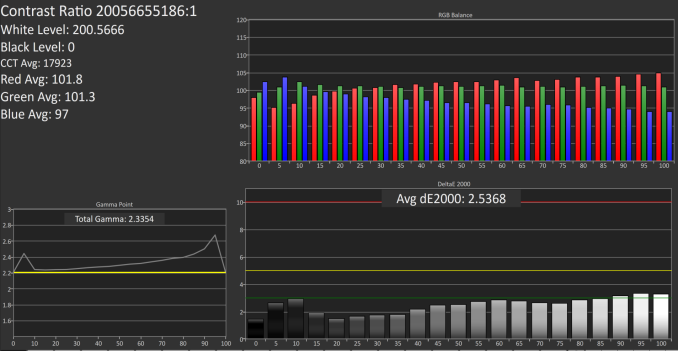
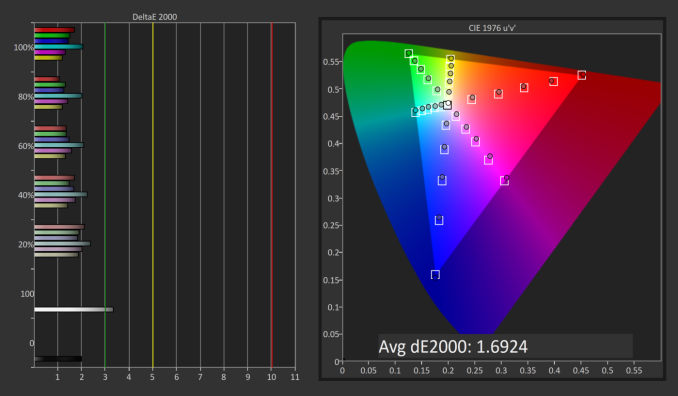
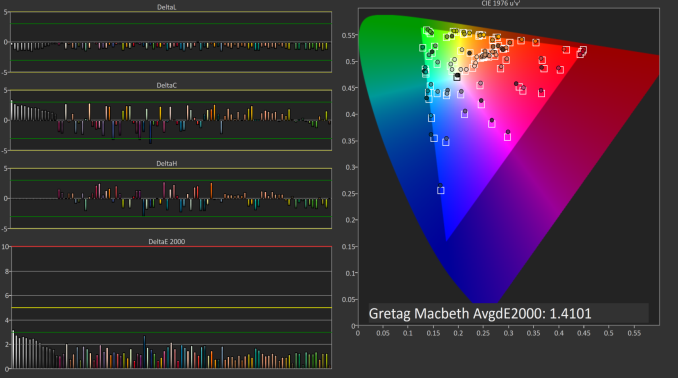
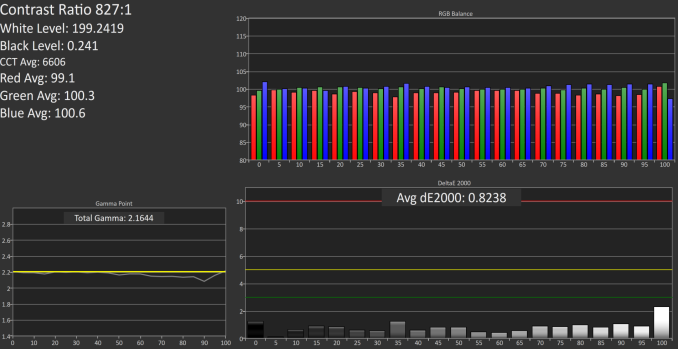
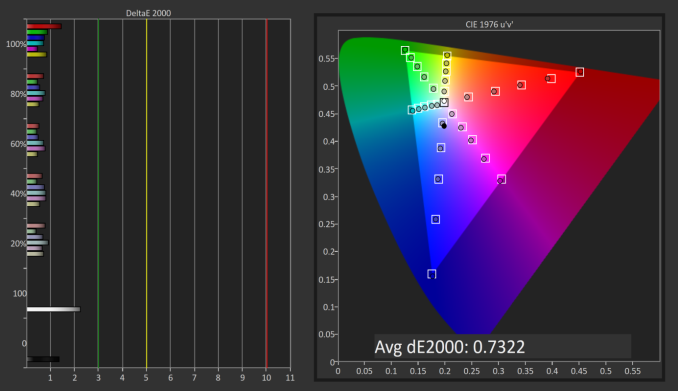
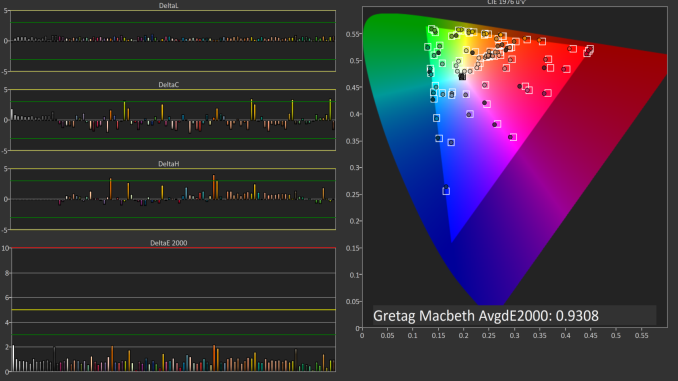
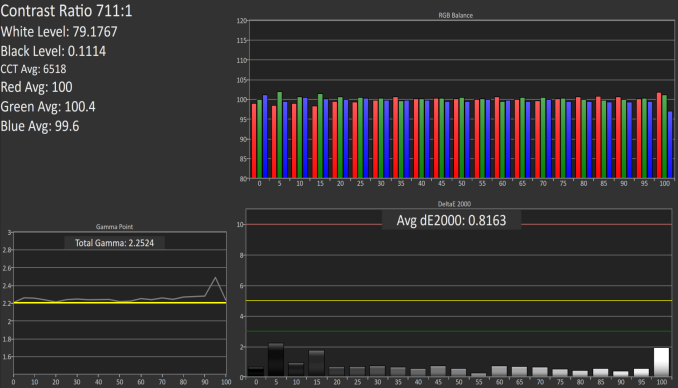
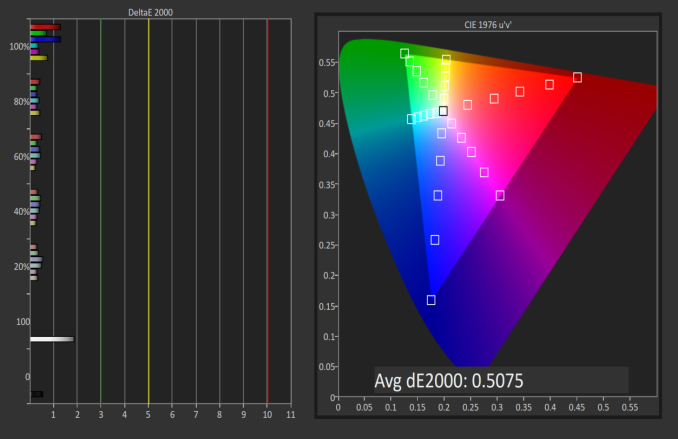
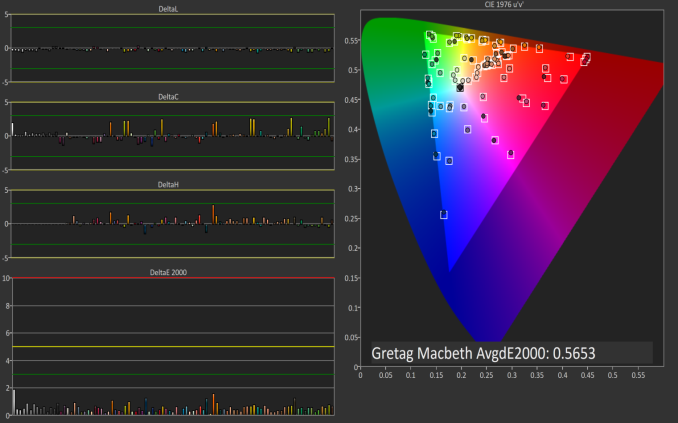










92 Comments
View All Comments
SanX - Wednesday, December 23, 2015 - link
Watch my lips: all that standard traditional PC monitor crap is dead. Monitors must be 4K 50+ inch size, period. I can not even look at that old junk after using for 6 months Samsung 50" 7100 4K TV. Despite it formally is a TV it's light years better then anything else called "PC monitor".The only defect -- it has no PnP functionality so that your PC can not switch it ON. As a result if your PC is ON and TV is off the PnP functionality of Windows may think that you changed monitor to standard resolution and move your open windows to the upper left corner. There exist software which can restore windows positions. It has one of the best latencies ~20ms so with GTX980TI class graphics card it is great for gamers too.
Zan Lynx - Wednesday, December 23, 2015 - link
I wouldn't say regular monitors are dead. I do agree that 50" 4K screens are amazing. It is exactly like having four 24" 1080p monitors in front of you without the obnoxious screen borders.AnnonymousCoward - Friday, December 25, 2015 - link
The Samsung 7100 lags 44ms in 4:4:4 mode, according to http://hardforum.com/showthread.php?t=1853884 That's totally unacceptable.SanX - Friday, December 25, 2015 - link
The only where this could be unacceptable is fast gaming for which there specially exist Game mode which halves the lag. Additional ms you get from high end graphics. Aside from games, in PC mode the 44 ms is still more then twice the human reaction time, I personally do not feel any lag at all, repeating, AT ALL. Monitor quality just overwhelms you, the wow factor is incredible. Do not look at any smaller regular monitors even 4k 28", like Samdung or ASUS, even for free, they are unacceptable in PC text use without scalingSlyNine - Friday, December 25, 2015 - link
Which means you're increasing reaction time by 50%.This would, and has, drove me nuts with tv's used as monitors.
AnnonymousCoward - Monday, December 28, 2015 - link
> more then twice the human reaction timeReaction time is different than observing feedback from your moved hand. The former requires you to interpret a stimulus and respond. The latter involves consciously moving and looking for the result. The difference is probably about a factor of 10: ~200ms reaction time, ~20ms threshold for seeing a result.
SanX - Saturday, December 26, 2015 - link
You still live with impressions of old TVs 50-100 ms lags playing games but things changed a lot.The 44ms lag for standard PC usage (browsing and programming) is absolutely great and not noticeable. For games you have Game Mode with 20-25ms lags which is not noticeable too unless you are a champion of the Republic of Gamers. No other TV monitors beat that (may be only Sammys JS7500 and the Vizio's with 18ms lag) while all Sonys, LGs etc TVs are in 33-55ms and longer range and still are used with for example Playstation for ages.
AnnonymousCoward - Sunday, December 27, 2015 - link
I easily notice 30ms lag with any mouse usage. I'm also a fast user with high acuity. I consider 20ms to be the max acceptable.Using non-4:4:4 in games is clearly a compromise.
It's not true that no other "TV monitor" beats the JU7100. check out this thread: http://hardforum.com/showthread.php?t=1874753 The Crossovers and Wasabi only lag 20ms in 4:4:4.
But hey, if you're a slow user and don't notice 44ms, that's great.
SanX - Sunday, December 27, 2015 - link
I repeat that the only where 44 ms is potentially niticeable is fast gaming, but for that exists game mode whete no one motice any lag as it is way below the human threshold. When I move mouse with as fast as possible circular motion for example I don't see any delay in position of mouse on the screen and on the table een recording this comparison on 30fps video (means it is below 33ms)Who trust your compilation from unknown sources obtained with unknown measurement methodology? Who would use unknown unrated brands? Who needs a monitor unusable for text and browsing because the monitor size MUST be 48 inch minimum to be comfortable for texts without DPI scaling, some people even claim 53 inch minimum? Those monitors you have mentioned are too small for multiple use. For gaming they are OK, for office use not, for use as a 4k TV - way too small, plus their quality is questionable.
Go to the best place which assesses all 4K monitors thoroughly for multiple use calles Rtings www.rtings.com/tv/reviews/by-usage/pc-monitor/best
AnnonymousCoward - Monday, December 28, 2015 - link
Man, you're wrong on pretty much everything :)I just told you, I NOTICE 30ms! But you still foolishly repeat 44ms can only be noticed in fast gaming. And 26ms game mode is beyond human detection. It's beyond YOUR detection, not everyone's! (is that not obvious yet?)
> Who trust your compilation from unknown sources obtained with unknown measurement methodology?
Do you have better data? Even if there's +-5ms of error, the data is immensely useful.
> Who would use unknown unrated brands?
They still use AH-IPS LG panels, and that's arguably _better_ than Samsung's VA.
> MUST be 48 inch minimum to be comfortable for texts without DPI scaling
Nope. 43" is only 103 PPI. And anything bigger is a lot less comfortable (with a normal viewing distance) since the screen is too big and you have to move your head around. Or, you get a 55" and push it farther back to prevent moving your head around, and then have an even higher effective PPI due to further viewing distance.